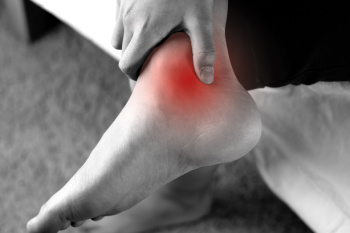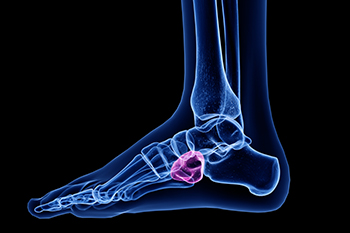Items filtered by date: March 2024
What Is Hyperhidrosis of the Feet?

Hyperhidrosis of the feet, a condition characterized by excessive sweating, can significantly impact daily life. Primary hyperhidrosis occurs without an underlying medical condition and often affects multiple areas, including the feet. Secondary hyperhidrosis stems from medical issues like hormonal imbalances or neurological disorders and may also affect the feet. Complications of hyperhidrosis include discomfort, odor, and an increased risk of skin infections like athlete's foot. Diagnosis typically involves a medical history review and physical examination. In some cases, tests like the starch-iodine test or the gravimetric test may be used to measure sweat production. Treatment options range from conservative measures to more invasive interventions. These include topical antiperspirants, iontophoresis, or using electrical currents to reduce sweat production. Additionally, oral medications like anticholinergics, botulinum toxin injections, and in severe cases, surgical procedures such as sympathectomy may be used to control hyperhidrosis. Tailored treatment plans depend on the severity of symptoms and individual patient preferences. If you have excessive sweating of the feet, it is suggested that you schedule an appointment with a podiatrist for a proper diagnosis and treatment.
If you are suffering from hyperhidrosis contact Scott Burdge, DPM of Advanced Ankle & Foot. Our doctor can provide the care you need to attend to all of your foot and ankle needs.
Hyperhidrosis of the Feet
Hyperhidrosis is a rare disorder that can cause people to have excessive sweating of their feet. This can usually occur all on its own without rigorous activity involved. People who suffer from hyperhidrosis may also experience sweaty palms.
Although it is said that sweating is a healthy process meant to cool down the body temperature and to maintain a proper internal temperature, hyperhidrosis may prove to be a huge hindrance on a person’s everyday life.
Plantar hyperhidrosis is considered to be the main form of hyperhidrosis. Secondary hyperhidrosis can refer to sweating that occurs in areas other than the feet or hands and armpits. Often this may be a sign of it being related to another medical condition such as menopause, hyperthyroidism and even Parkinson’s disease.
In order to alleviate this condition, it is important to see your doctor so that they may prescribe the necessary medications so that you can begin to live a normal life again. If this is left untreated, it is said that it will persist throughout an individual’s life.
A last resort approach would be surgery, but it is best to speak with your doctor to find out what may be the best treatment for you.
If you have any questions please feel free to contact our office located in Katy, TX . We offer the newest diagnostic and treatment technologies for all your foot and ankle needs.
We Can Treat Your Foot or Ankle Pain
What Is Tarsal Tunnel Syndrome?
 Tarsal tunnel syndrome is a compressive neuropathy condition that results from the entrapment of the posterior tibial nerve as it passes through the tarsal tunnel, a narrow passageway located on the inner side of the ankle. This entrapment leads to many symptoms, most notably pain, tingling, and burning in the foot and heel, which sometimes extends into the toes and lower leg. Many things can cause tarsal tunnel syndrome, such as injuries to the ankle, swelling from other health problems like diabetes, or just by repeating the same movements that irritate the area. Treatment strategies are tailored to the severity and underlying cause of the syndrome. Conservative measures include anti-inflammatory medications and orthotic devices to alleviate pressure on the nerve. More invasive options include surgical decompression to relieve the nerve entrapment. Tarsal tunnel syndrome can be hard to diagnose because its symptoms overlap with other nerve-related conditions. Podiatrists, or foot doctors, can do comprehensive evaluations to properly diagnose tarsal tunnel syndrome. If you have foot pain, or suspect tarsal tunnel syndrome, it is suggested that you seek treatment from a podiatrist who can properly diagnose this condition and offer a personalized treatment plan.
Tarsal tunnel syndrome is a compressive neuropathy condition that results from the entrapment of the posterior tibial nerve as it passes through the tarsal tunnel, a narrow passageway located on the inner side of the ankle. This entrapment leads to many symptoms, most notably pain, tingling, and burning in the foot and heel, which sometimes extends into the toes and lower leg. Many things can cause tarsal tunnel syndrome, such as injuries to the ankle, swelling from other health problems like diabetes, or just by repeating the same movements that irritate the area. Treatment strategies are tailored to the severity and underlying cause of the syndrome. Conservative measures include anti-inflammatory medications and orthotic devices to alleviate pressure on the nerve. More invasive options include surgical decompression to relieve the nerve entrapment. Tarsal tunnel syndrome can be hard to diagnose because its symptoms overlap with other nerve-related conditions. Podiatrists, or foot doctors, can do comprehensive evaluations to properly diagnose tarsal tunnel syndrome. If you have foot pain, or suspect tarsal tunnel syndrome, it is suggested that you seek treatment from a podiatrist who can properly diagnose this condition and offer a personalized treatment plan.
Tarsal tunnel syndrome can be very uncomfortable to live with. If you are experiencing tarsal tunnel syndrome, contact Scott Burdge, DPM of Advanced Ankle & Foot. Our doctor can provide the care you need to keep you pain-free and on your feet.
Tarsal Tunnel Syndrome
Tarsal tunnel syndrome, which can also be called tibial nerve dysfunction, is an uncommon condition of misfiring peripheral nerves in the foot. The tibial nerve is the peripheral nerve in the leg responsible for sensation and movement of the foot and calf muscles. In tarsal tunnel syndrome, the tibial nerve is damaged, causing problems with movement and feeling in the foot of the affected leg.
Common Cause of Tarsal Tunnel Syndrome
- Involves pressure or an injury, direct pressure on the tibial nerve for an extended period of time, sometimes caused by other body structures close by or near the knee.
- Diseases that damage nerves, including diabetes, may cause tarsal tunnel syndrome.
- At times, tarsal tunnel syndrome can appear without an obvious cause in some cases.
The Effects of Tarsal Tunnel Syndrome
- Different sensations, an afflicted person may experience pain, tingling, burning or other unusual sensations in the foot of the affected leg.
- The foot muscles, toes and ankle become weaker, and curling your toes or flexing your foot can become difficult.
- If condition worsens, infections and ulcers may develop on the foot that is experiencing the syndrome.
A physical exam of the leg can help identify the presence of tarsal tunnel syndrome. Medical tests, such as a nerve biopsy, are also used to diagnose the condition. Patients may receive physical therapy and prescriptive medication. In extreme cases, some may require surgery.
If you have any questions please feel free to contact our office located in Katy, TX . We offer the newest diagnostic and treatment technologies for all your foot and ankle needs.
Cuboid Syndrome in Athletes
 Cuboid syndrome is a prevalent source of lateral midfoot discomfort in athletes. It is thought that it might happen when there's a small problem with the joint in the middle of the foot. Symptoms closely resemble those of ligament sprains. Definitive diagnostic tests for the condition are currently unavailable. However, some studies show good responses to joint manipulation and external support. Despite the absence of evidence-based guidelines, diagnosing cuboid syndrome often relies on recognizing a combination of signs and symptoms. Manipulation of the cuboid is typically considered as an initial treatment option unless contraindicated. If you are an athlete and have persistent pain in your midfoot area, it is suggested that you make an appointment with a podiatrist to have your foot examined and a determination made as to whether cuboid syndrome might be the cause. Then, you can get the right treatment.
Cuboid syndrome is a prevalent source of lateral midfoot discomfort in athletes. It is thought that it might happen when there's a small problem with the joint in the middle of the foot. Symptoms closely resemble those of ligament sprains. Definitive diagnostic tests for the condition are currently unavailable. However, some studies show good responses to joint manipulation and external support. Despite the absence of evidence-based guidelines, diagnosing cuboid syndrome often relies on recognizing a combination of signs and symptoms. Manipulation of the cuboid is typically considered as an initial treatment option unless contraindicated. If you are an athlete and have persistent pain in your midfoot area, it is suggested that you make an appointment with a podiatrist to have your foot examined and a determination made as to whether cuboid syndrome might be the cause. Then, you can get the right treatment.
Cuboid syndrome, also known as cuboid subluxation, occurs when the joints and ligaments near the cuboid bone in the foot become torn. If you have cuboid syndrome, consult with Scott Burdge, DPM from Advanced Ankle & Foot. Our doctor will assess your condition and provide you with quality foot and ankle treatment.
Cuboid syndrome is a common cause of lateral foot pain, which is pain on the outside of the foot. The condition may happen suddenly due to an ankle sprain, or it may develop slowly overtime from repetitive tension through the bone and surrounding structures.
Causes
The most common causes of cuboid syndrome include:
- Injury – The most common cause of this ailment is an ankle sprain.
- Repetitive Strain – Tension placed through the peroneus longus muscle from repetitive activities such as jumping and running may cause excessive traction on the bone causing it to sublux.
- Altered Foot Biomechanics – Most people suffering from cuboid subluxation have flat feet.
Symptoms
A common symptom of cuboid syndrome is pain along the outside of the foot which can be felt in the ankle and toes. This pain may create walking difficulties and may cause those with the condition to walk with a limp.
Diagnosis
Diagnosis of cuboid syndrome is often difficult, and it is often misdiagnosed. X-rays, MRIs and CT scans often fail to properly show the cuboid subluxation. Although there isn’t a specific test used to diagnose cuboid syndrome, your podiatrist will usually check if pain is felt while pressing firmly on the cuboid bone of your foot.
Treatment
Just as the range of causes varies widely, so do treatments. Some more common treatments are ice therapy, rest, exercise, taping, and orthotics.
If you have any questions, please feel free to contact our office located in Katy, TX . We offer the newest diagnostic and treatment technologies for all your foot care needs.
Ankle Fractures

A fractured bone occurs when external force exceeds bone strength, resulting in pain, limited function, and potential bleeding. Bones are composed of calcium reinforced connective tissue with bone marrow producing blood cells. Bones support the body, aid movement, and shield internal organs. Fracture severity varies based on force, bone involved, age, and health. Common fractures include ankle fractures, more prevalent among older adults. Causes include accidents and conditions like osteoporosis. Symptoms include pain, swelling, and deformity. If you have sustained an ankle fracture, it is suggested that you schedule an appointment with a podiatrist as quickly as possible to ensure proper healing and regain optimal function.
Broken ankles need immediate treatment. If you are seeking treatment, contact Scott Burdge, DPM from Advanced Ankle & Foot. Our doctor can provide the care you need to keep you pain-free and on your feet.
Broken Ankles
A broken ankle is experienced when a person fractures their tibia or fibula in the lower leg and ankle area. Both of these bones are attached at the bottom of the leg and combine to form what we know to be our ankle.
When a physician is referring to a break of the ankle, he or she is usually referring to a break in the area where the tibia and fibula are joined to create our ankle joint. Ankles are more prone to fractures because the ankle is an area that suffers a lot of pressure and stress. There are some obvious signs when a person experiences a fractured ankle, and the following symptoms may be present.
Symptoms of a Fractured Ankle
- Excessive pain when the area is touched or when any pressure is placed on the ankle
- Swelling around the area
- Bruising of the area
- Area appears to be deformed
If you suspect an ankle fracture, it is recommended to seek treatment as soon as possible. The sooner you have your podiatrist diagnose the fracture, the quicker you’ll be on the way towards recovery.
If you have any questions, please feel free to contact our office located in Katy, TX . We offer the newest diagnostic and treatment technologies for all your foot care needs.




